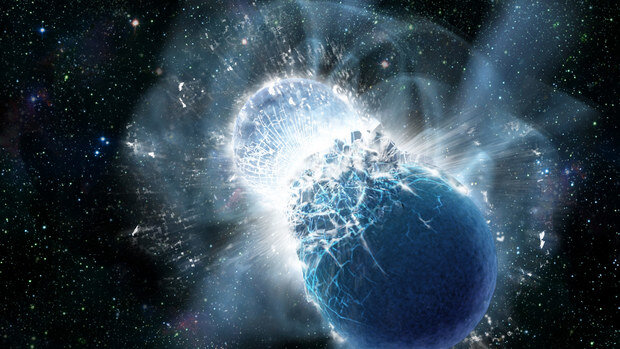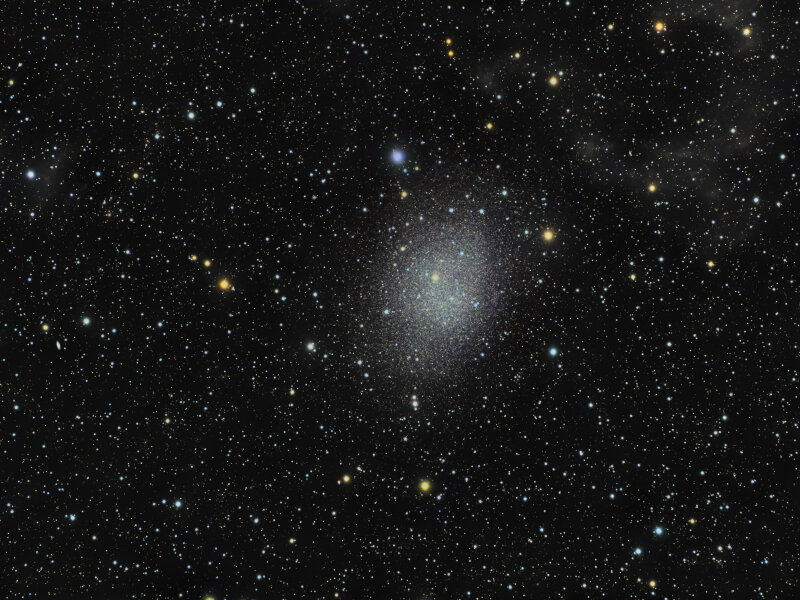有钱的三小只 The Three Rich Ones
对很多人来说,那些金属基本知识的记忆可能还停留在那些高中教室中吧。室温下的它们大多是固体的,表明都是有光泽的 ……
For many people, those definitions of metals are probably left behind at those high school classrooms, where we were told they are mostly solid under room temperature, they are all shiny, they are…
然而,与化学家们不同的是,对于天体物理学来说,所有比氢和氦重的元素都被称为金属。
所以,你知道吗?宇宙中最丰富的“金属”是氧和碳!
However, unlike chemists, for astrophysicistsall elements heavier than hydrogen and helium are called metals. So, did you know? The most abundant ‘metals’in our universe are oxygen and carbon!
但是今天我们要讨论的还是那些正真的金属。重的那些哦!
However today we will be talking about actual metals. The heavy ones!
图为约1500光年外的梅西耶42(猎户座星云),是离地球最近的大型恒星形成区域,也是外太空最早发现氧分子(O2)的地方之一
The Messier 42(Orion Nebula), about 1,500 light-years away, is the closest large star-forming region to Earth. One of the first places in outer space where molecular oxygen (O2) were discovered
幸运儿的诞生
Birth of the Lucky Ones
宇宙中许多元素的形成,要么是在恒星生命周期结束时内核坍缩超新星的时候,要么是在白矮星死亡时,热核超新星的时候。但千千万万平凡中总会有些个幸运儿,能够更早地获得探索宇宙的机会,从另一条特殊的路被护送而来。
While many elements would only start to be formed either at the end of a star’s lifetime during their core-collapse supernova or at the death of a white dwarf as a thermonuclear supernova, however some lucky ones are able to get the chance of exploring the universe earlier. They got to be sent here through a different pipeline!
在元素的世界里,这些优先通道包括s过程和r过程,分别代表了慢中子捕获过程和快中子捕获过程。在星星中,轻核捕获中子后将产生富含中子的核,但具体产生哪一种元素将取决于过程的速度。而这两个过程就代表了每个粒子的不同旅程,加起来就会对恒星的生命产生整体影响。
For elements, those priority channels include the s-process and r-process, referring to slow and rapid neutron capture processes respectively. The capture of neutrons on light nuclei will produce neutron-rich nuclei, but which element exactly produced would depend on the speed of the process. They are the journeys of single particles and added up to become an overall effect on the life of a star.
s过程一般发生在低质量恒星生命的最后阶段,尤其在渐近巨分支(AGB)恒星中常见。而r过程需要在短时间内收集更多的中子才会有条件发生,条件较为严苛,有两种可能的场景:双中子星合并或奇异超新星。
The s-process occurs in stars, particularly Asymptotic Giant Branch (AGB) stars, at the very end of low mass stars’ lives. One the other hand, r-processrequires a lot more neutrons in a short period for the processes to happen, hence a harsher condition, and there are two potential ways: binary neutron star mergers and exotic supernovae.
图为两颗中子星碰撞的瞬间艺术创作
An artist conception of the moment two neutron stars collide
移民者的家乡
Home of the Immigrants
虽然至今已有上百年的研究,但宇宙中重金属元素的起源仍然是一个相对未知的领域。科研人员们主要还是利用恒星的光谱来研究它们,然后从中提取每种物质的丰富程度。
Until today, the origin of heavy metal elements in the universe is still a relatively unknown area. Researchers have been studying them primarily by using the spectra of stars and finding the abundance of each material.
最近,对含有r过程的恒星的研究表明,我们星系中的许多重金属恒星其实来自我们邻近的矮星系,是我们银河系的移民。
Recently, studies of r-process stars have suggested that many of the heavy metal stars in our galaxy might have come from our neighbouring dwarf galaxies, immigrants to our Milky Way.
为了对r过程有更深入的了解,德国和丹麦的一组天体物理学家开始了他们对隔壁矮球星系 - 天炉星系(Fornax)的研究。它是本星系群中最大的矮星系之一,有着独特的恒星形成历史,恒星形成仅在大约4十亿之前突然增加。
In order to have a deeper understanding of the r-process, a group of astrophysicists in Germany and Denmark stared their research on the dwarf spherical galaxy (dSph) – Fornax, next door. Being one of the largest of its kind in the Local Group, it has a unique star formation history with a sudden increase of star formation only ∼ 4 Gyr ago.
图为天炉矮星系(又名MCG-06-07-001, PCG10093),是一个椭圆形的老恒星群
The Fornax Dwarf galaxy (aka MCG-06-07-001, PCG10093) an ellipsoidally shaped swarm of old stars
谁比谁更多金
Who Has the Most Metals?
在对天炉星系的恒星群进行研究时,研究小组发现了三颗非常独特的恒星,它们含有比其他恒星多得多的r过程元素。特别是,铕(Eu)元素的丰度程度几乎是其他元素的10倍。是迄今为止观测到的铕含量最高的恒星,以下它们将被称为铕恒星。
During the study of Fornax’s stellar population, the team found three very unique stars containing significantly more r-processed elements than the rest of the population. In particular, the abundance of the rare element europium (Eu) was almost ten times more compared to the others in Fornax. They are the highest Eu abundance ever observed, here they will be call Eu-stars.
图为样本恒星的坐标,大椭圆为标称潮汐半径,小虚线椭圆为核心半径。黑色十字为星系的中心,绿色的十字为天炉星系的球状星团,以及那三颗特殊的恒星分别为橙色菱形、圆圈和方形
The coordinates of sample stars, the large oval shows the nominal tidal radius and the small dashed oval the core radius. Cyan crosses indicate the globular clusters of Fornax and the three special stars as orange diamond, a circle and a square
虽然r过程恒星和普通恒星的金属值 (铁/氢比值)与铕丰度之间普遍存在一个趋势,但这里,r过程对那些恒星的铕含量的增强明显高于了,在其他金属控制在一定范围内的,平均值。
Although generally there is a trend between the metallicity (Fe/H ratio) and the abundance of Eu for both r-process enhanced stars and those normal ones, the enhancement here refers to having the amount of Eu significantly above the average with given metallicity.
为了找出这三颗恒星可能含有这么多铕的原因,研究小组比较了铕恒星和普通恒星的alpha丰度(alpha指由大质量恒星的聚变产生的元素,如镁)。这个测试将告诉我们铕是否来自于恒星本身的聚变过程,而令人惊讶的是,结果表明铕恒星并不是由alpha过程得到那些铕的。
To find why those three might possess so much Eu, the team compared the alpha abundance (elements created in massive stars from fusion, e.g. Mg) of the Eu-stars and normal stars. This test will tell if the Eu came from fusion processes of the star itself or not, surprisingly results show that the Eu-stars are not alpha process enhanced.
因此,这些r过程恒星中的铕要么来自中子星合并(因为这些系统中缺乏氦),要么是一颗超新星在爆发的时候除了在这三颗恒星中留下了额外的铕外,没有利益alpha元素在任何其他地方留下痕迹。
Therefore, the Eu in those r-process stars either came from a neutron star merger (due to the lack of helium in these systems) or a supernova created this but didn’t leave a signature on the alpha elements except for the extra Eu in those three stars.
上图:与恒星金属丰度相比的绝对铕丰度,下图:与恒星金属丰度相比的铕丰度(相对于铁丰度)。灰色点是银河系的恒星,绿色的是天炉星系的恒星。
Top panel: Absolute Eu abundances as compared to the stellar metallicity. Bottom panel: Eu abundances (relative to the iron abundance) as compared to the stellar metallicity. The gray points are Milky Way stars and the green stars are Fornax stars.
经历了什么?
What Happened to Them?
像铕这样的中子捕获元素可以通过s过程或r过程产生。那么为什么这三颗星被定义为r过程恒星?答案可以用钡与铕的比值([Ba/Eu])可以来测试。
Neutron capture elements like Eu can be produced with both the s-process and r-process. So why are those three stars defined to be r-processed?
Well, the barium to europium ratio ([Ba/Eu]) can be used to test it.
当r过程占主导地位时,钡铕比值会较低,反之,s过程占主导地位时比值便会较高。因此,当铕恒星的钡铕比值已经低于-0.7 dex时,它们被证明是纯r过程而来的。另一方面,天炉星系中其余成员们都被认为是 r过程和s过程中子捕获的组合而来的。
When the r-process is dominant, radio would be low, conversely, the ratio would be high if s-process is dominant. Therefore, with radio below -0.7 dex for the Eu-stars, they are proven to be pure r-processed. On the other hand, the rest of the population in Fornax are seen to be from a combination of r-process and s-process neutron captures.
但这三个为什么如此特别呢?他们究竟经历了什么?
But why are those three so special? What did they go through to end up like this?
为了找到答案,研究小组计算了让恒星富含铕所需的r过程数量。他们发现,一个r过程仅仅需要太阳质量的千分之一到万分之一的铕,但只需要一个r过程就可以让这三颗恒星都变得特别。更多的r过程都将导致天炉星系中的那三小只不再特别。
To find out, the team calculated the number of r-process events necessary to enrich the stars with Eu. They find that a single r-process event would require around ten-thousandth to a thousandth solar mass of Eu, but only a single event is needed to make those three stars special. Any more of the Eu r-process will lead to large spreads of r-process to stars in Fornax.
图为由r过程事件产生的恒星的铕绝对丰度,与受r过程影响的总气体质量关系。阴影部分代表产生的铕质量,黑色和红色线分别表示中子星合并和超新星的理论预测。黄色方框区域代表与本研究中的铕恒心相对应的近似区域
Absolute Eu abundance of stars created from an r-process events as compared to the total gas mass affected by the r-process event. The shading represents the Eu mass created, the black and red lines indicating theoretical predictions for neutron star mergers and supernovae respectively, and yellow box the approximate region corresponding to the Eu-stars in this study.
还是看不清
Still Blurry
那现在唯一的问题就是:这第一个,也是最后一个r过程是怎么开始的呢?要么是中子星合并,要么是超新星。
So now the only question is what triggered the first but also last r-process? It would either a neutron star merger or a supernova.
遗憾的是,由于这两个事件的理论模型均有不确定性,研究小组无法确定是到底是哪一个对铕恒星负责任,所以这也是我们将来要解决的谜题之一。
Unfortunately, due to the uncertainties of the theoretical modeling of these events, the team wasn’t able to definitively state which one is responsible for the Eu-stars, leaving us more mysteries to resolve.
这次对天炉矮星系的研究为完全理解中子捕获过程和重金属‘铸造’又迈进了大大的一步。虽然由于详细的数据匮乏,我们仍然无法确定产生过量中子俘获物质的确切物理事件,但我们已经证实了铕恒星的起源来自r过程。
This deep look Fornax has provided a large step forward in our understanding of neutron capture processes and heavy metal 'casting'. Though we are still unable to pinpoint the exact physical event creating the excess neutron capture material due to the absence of detailed data, it was confirmed that the Eu-stars originating from the r-process event.
与天体物理的许多研究一样,
随着对更多空中那些
不断的发现和研究,
总有一天我们会找到所有
那些明亮而美丽事物的真正起源
As always, in astrophysics,
with continuing discoveries
and studies of more things out there,
one day we will find the true origin
of all those bright and beautiful.
图为NASA拍到的Menagerie超新星遗迹,也被称为N 63A。是一颗大质量恒星爆炸后,其气态层喷射到已经很混杂的区域的残骸
The Supernova Remnant Menagerie, aka N 63A. It is the remains of a massive star that exploded, spewing its gaseous layers out into an already turbulent region
图片和视频来自 NASA, LIGO, Cosmicphotos官网以及以下论文
文中部分英文信息参考来自 M.Reichert, C.J.Hansen 和 A.Arcones 的 ‘Extreme r-process enhanced stars at high metallicity in Fornax‘ 论文
其余中英文内容为原创
Images from official website of NASA, LIGO, Cosmicphotos and the below articles
Parts are sited from ‘Extreme r-process enhanced stars at high metallicity in Fornax‘ from M.Reichert, C.J.Hansen and A.Arcones
The rest of the Chinese and English content are original







